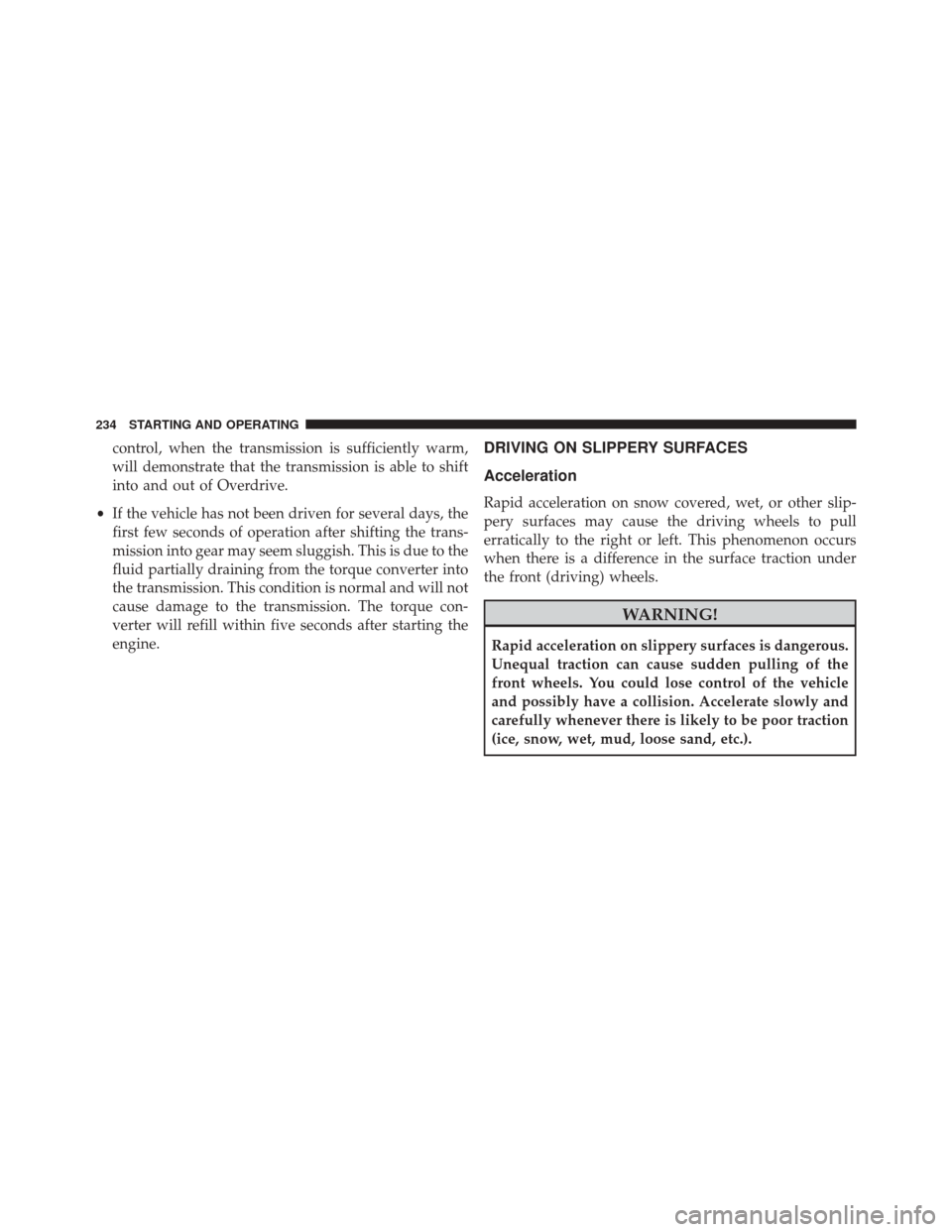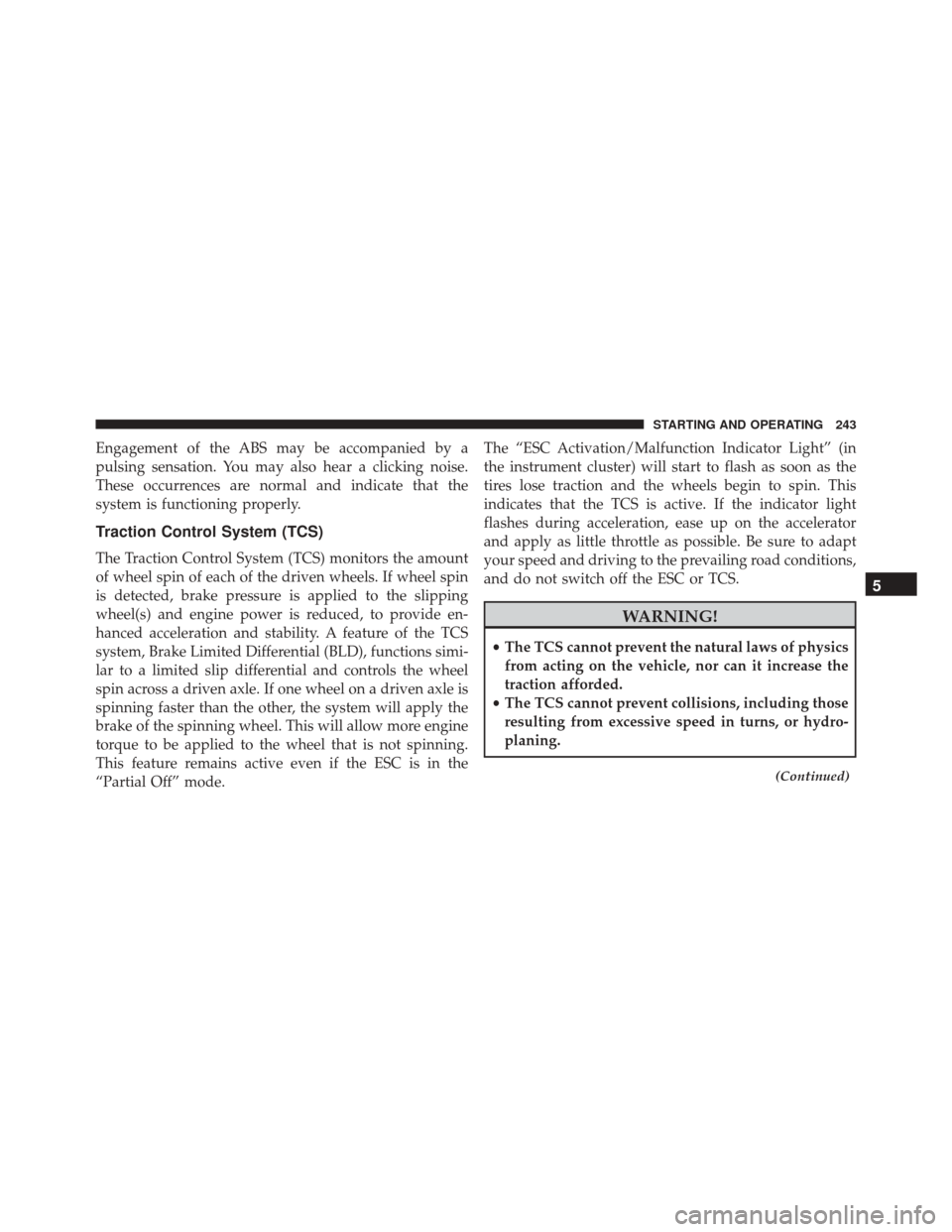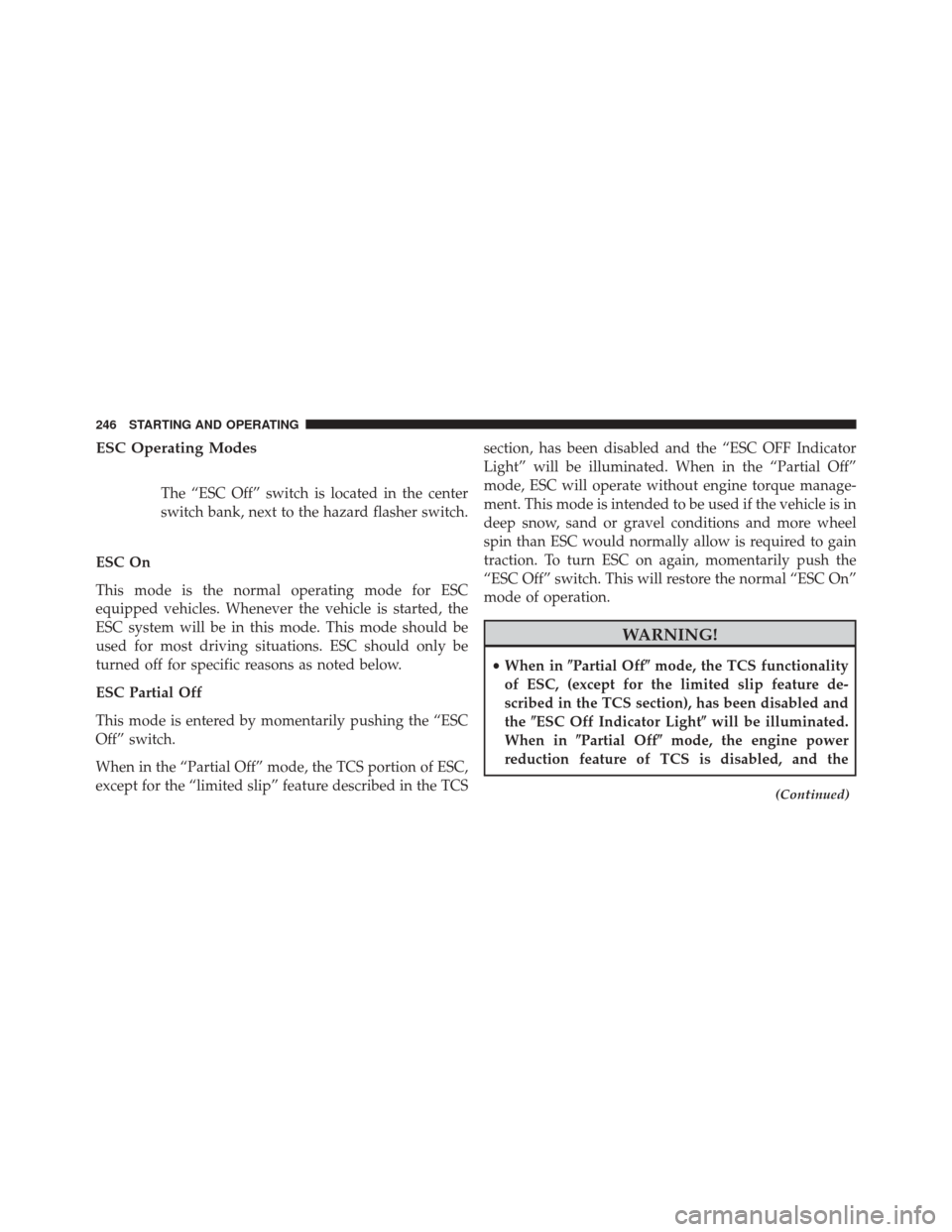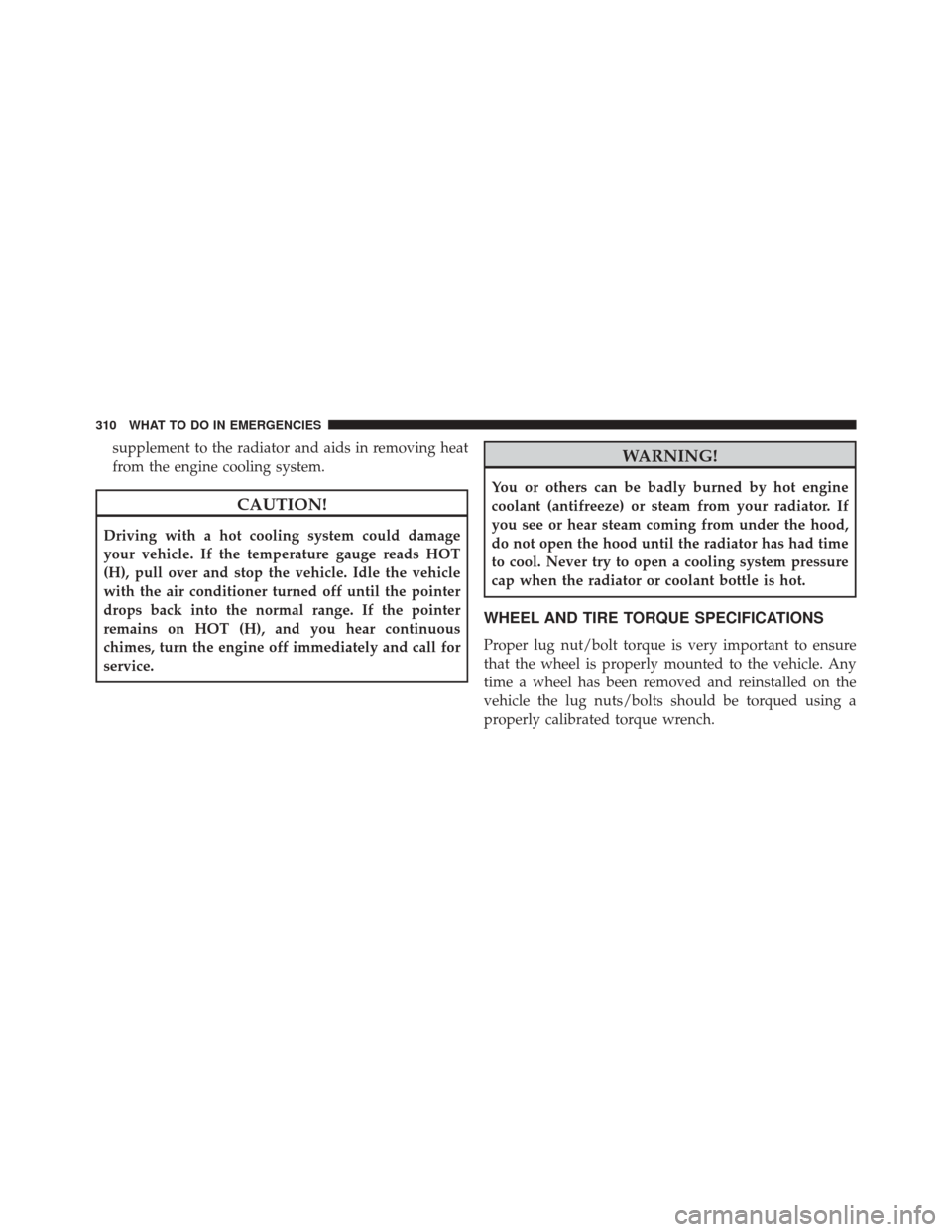Page 236 of 448

control, when the transmission is sufficiently warm,
will demonstrate that the transmission is able to shift
into and out of Overdrive.
• If the vehicle has not been driven for several days, the
first few seconds of operation after shifting the trans-
mission into gear may seem sluggish. This is due to the
fluid partially draining from the torque converter into
the transmission. This condition is normal and will not
cause damage to the transmission. The torque con-
verter will refill within five seconds after starting the
engine.DRIVING ON SLIPPERY SURFACES
Acceleration
Rapid acceleration on snow covered, wet, or other slip-
pery surfaces may cause the driving wheels to pull
erratically to the right or left. This phenomenon occurs
when there is a difference in the surface traction under
the front (driving) wheels.
WARNING!
Rapid acceleration on slippery surfaces is dangerous.
Unequal traction can cause sudden pulling of the
front wheels. You could lose control of the vehicle
and possibly have a collision. Accelerate slowly and
carefully whenever there is likely to be poor traction
(ice, snow, wet, mud, loose sand, etc.).
234 STARTING AND OPERATING
Page 245 of 448

Engagement of the ABS may be accompanied by a
pulsing sensation. You may also hear a clicking noise.
These occurrences are normal and indicate that the
system is functioning properly.
Traction Control System (TCS)
The Traction Control System (TCS) monitors the amount
of wheel spin of each of the driven wheels. If wheel spin
is detected, brake pressure is applied to the slipping
wheel(s) and engine power is reduced, to provide en-
hanced acceleration and stability. A feature of the TCS
system, Brake Limited Differential (BLD), functions simi-
lar to a limited slip differential and controls the wheel
spin across a driven axle. If one wheel on a driven axle is
spinning faster than the other, the system will apply the
brake of the spinning wheel. This will allow more engine
torque to be applied to the wheel that is not spinning.
This feature remains active even if the ESC is in the
“Partial Off” mode.The “ESC Activation/Malfunction Indicator Light” (in
the instrument cluster) will start to flash as soon as the
tires lose traction and the wheels begin to spin. This
indicates that the TCS is active. If the indicator light
flashes during acceleration, ease up on the accelerator
and apply as little throttle as possible. Be sure to adapt
your speed and driving to the prevailing road conditions,
and do not switch off the ESC or TCS.
WARNING!
•
The TCS cannot prevent the natural laws of physics
from acting on the vehicle, nor can it increase the
traction afforded.
• The TCS cannot prevent collisions, including those
resulting from excessive speed in turns, or hydro-
planing.
(Continued)
5
STARTING AND OPERATING 243
Page 248 of 448

ESC Operating Modes
The “ESC Off” switch is located in the center
switch bank, next to the hazard flasher switch.
ESC On
This mode is the normal operating mode for ESC
equipped vehicles. Whenever the vehicle is started, the
ESC system will be in this mode. This mode should be
used for most driving situations. ESC should only be
turned off for specific reasons as noted below.
ESC Partial Off
This mode is entered by momentarily pushing the “ESC
Off” switch.
When in the “Partial Off” mode, the TCS portion of ESC,
except for the “limited slip” feature described in the TCS section, has been disabled and the “ESC OFF Indicator
Light” will be illuminated. When in the “Partial Off”
mode, ESC will operate without engine torque manage-
ment. This mode is intended to be used if the vehicle is in
deep snow, sand or gravel conditions and more wheel
spin than ESC would normally allow is required to gain
traction. To turn ESC on again, momentarily push the
“ESC Off” switch. This will restore the normal “ESC On”
mode of operation.
WARNING!
•
When in �Partial Off� mode, the TCS functionality
of ESC, (except for the limited slip feature de-
scribed in the TCS section), has been disabled and
the �ESC Off Indicator Light� will be illuminated.
When in �Partial Off� mode, the engine power
reduction feature of TCS is disabled, and the
(Continued)
246 STARTING AND OPERATING
Page 309 of 448
WHAT TO DO IN EMERGENCIES
CONTENTS
�HAZARD WARNING FLASHERS ...........309
� IF YOUR ENGINE OVERHEATS ............309
� WHEEL AND TIRE TORQUE
SPECIFICATIONS ..................... .310
▫ Torque Specifications ...................311
� TIRE SERVICE KIT — IF EQUIPPED .........312
▫ Tire Service Kit Storage .................313
▫ Tire Service Kit Components And Operation . .313
▫ Tire Service Kit Usage Precautions .........314
▫ Sealing A Tire With Tire Service Kit ........317�
JACKING AND TIRE CHANGING ..........323
▫ Jack Location ........................ .323
▫ Removing The Spare Tire ................324
▫ Preparations ........................ .328
▫ Jacking Instructions ....................329
▫ Wheel Covers ....................... .338
� JUMP-STARTING PROCEDURES ...........338
▫ Preparations For Jump-Start ..............339
▫ Jump-Starting Procedure ................341
▫ Battery Location ..................... .343
6
Page 312 of 448

supplement to the radiator and aids in removing heat
from the engine cooling system.
CAUTION!
Driving with a hot cooling system could damage
your vehicle. If the temperature gauge reads HOT
(H), pull over and stop the vehicle. Idle the vehicle
with the air conditioner turned off until the pointer
drops back into the normal range. If the pointer
remains on HOT (H), and you hear continuous
chimes, turn the engine off immediately and call for
service.
WARNING!
You or others can be badly burned by hot engine
coolant (antifreeze) or steam from your radiator. If
you see or hear steam coming from under the hood,
do not open the hood until the radiator has had time
to cool. Never try to open a cooling system pressure
cap when the radiator or coolant bottle is hot.
WHEEL AND TIRE TORQUE SPECIFICATIONS
Proper lug nut/bolt torque is very important to ensure
that the wheel is properly mounted to the vehicle. Any
time a wheel has been removed and reinstalled on the
vehicle the lug nuts/bolts should be torqued using a
properly calibrated torque wrench.
310 WHAT TO DO IN EMERGENCIES
Page 313 of 448
Torque Specifications
Lug Nut/Bolt Torque **Lug Nut/Bolt SizeLug Nut/
Bolt
Socket Size
145 Ft-Lbs (197 N·m) M16 x 1.50 21 mm
**Use only your Authorized Dealer recommended lug
nuts/bolts and clean or remove any dirt or oil before
tightening.
Inspect the wheel mounting surface prior to mounting
the tire and remove any corrosion or loose particles. Tighten the lug nuts/bolts in a star pattern until each
nut/bolt has been tightened twice.
Wheel Mounting Surface
6
WHAT TO DO IN EMERGENCIES 311
Page 314 of 448
After 25 miles (40 km) check the lug nut/bolt torque to be
sure that all the lug nuts/bolts are properly seated
against the wheel.
WARNING!
To avoid the risk of forcing the vehicle off the jack,
do not tighten the lug nuts fully until the vehicle has
been lowered. Failure to follow this warning may
result in personal injury.
TIRE SERVICE KIT — IF EQUIPPED
Small punctures up to 1/4 inch (6 mm) in the tire tread
can be sealed with Tire Service Kit. Foreign objects (e.g.,
screws or nails) should not be removed from the tire. Tire
Service Kit can be used in outside temperatures down to
approximately -4°F (-20°C).
This kit will provide a temporary tire seal, allowing you
to drive your vehicle up to 100 miles (160 km) with a
maximum speed of 55 mph (90 km/h).
Torque Patterns
312 WHAT TO DO IN EMERGENCIES
Page 336 of 448
WARNING!
To avoid the risk of forcing the vehicle off the jack,
do not tighten the wheel nuts fully until the vehicle
has been lowered. Failure to follow this warning may
result in personal injury.
NOTE: Do not install the wheel cover on the spare tire.
7. Lower the vehicle by turning the jack screw to the left.
8. Refer to “Torque Specifications” in this section for proper wheel lug bolt torque.
9. Lower the jack to its fully-closed position.
10. Stow the damaged wheel/spare tire with the cable and wheel spacer before driving the vehicle. 11. Install the winch extension and
rotate the wrench
handle clockwise until the winch mechanism indi-
cation window turns yellow and the operator hears
“3 clicks” from the device to show the wheel is
properly stowed under the vehicle.
Winch Mechanism Properly Engaged (Yellow DOT Will
Appear In The Winch Indication Window)
334 WHAT TO DO IN EMERGENCIES